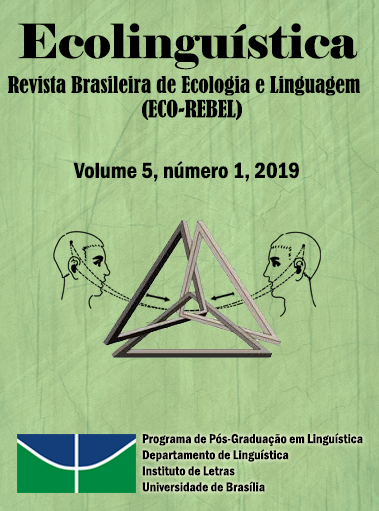Promoting critical literacy
the case of promotional materials for burgers
Palabras clave:
Letramento crítico; alimento à base de planta; sanduíches; ensino de língua; análise crítica do discurso.Resumen
Este artigo explica o que vem a ser letramento crítico, porque ele deve ser incluído no ensino de línguas e como incluir letramento crítico na educação linguística. Um exemplo de como praticar letramento crítico é apresentado mediante um projeto piloto de análise crítica de material de propaganda de sanduíches, tanto feitos da carne de animais assassinados quanto produzidos a partir de ingredientes oriundos de plantas. O projeto está descrito em detalhes, incluindo-se os textos e imagens analisados. Ademais, os autores apresentam sugestões de como implementar cinco princípios pedagógicos relavantes para o aprendizado de letramento crítico e de educação em geral. Esses princípios são: os estudantes devem ser aprendizes ativos; eles devem ter alguma informação sobre o que estudam e como estudá-lo; as tarefas devem ser factíveis para os estudantes, mas envolver algum desafio; os estudantes devem ter oportunidades de interagir com os colegas e com outros; o aprendizado deve contribuir para fazer do mundo um lugar melhor.
Descargas
Citas
ADAMS, C. J. The sexual politics of meat: A feminist-vegetarian critical theory. New York, NY: Bloomsbury Publishing, 20105.
______. The Carol J. Adams reader. London, United Kingdom: Bloomsbury, 2016.
BEHRMAN, E. H.Teaching about language, power, and text: A review of classroom practices that support critical literacy.Journal of Adolescent & Adult Literacy,49(6), 2006, p. 490-498. DOI: https://doi.org/10.1598/JAAL.49.6.4
BEYOND MEAT.Author. Retrieved from http://beyondmeat.com
_______. Beast Burger 2.0, 2018b. Retrieved fromhttp://beyondmeat.com/products/view/the-beast-burger
BROUGH, A. R., & WILKIE, J. E. B.Men resist green behavior as unmanly: A surprising reason for resistance to environmental goods and habits, Scientific American, 2017. Retrieved from https://www.scientificamerican.com/article/men-resist-green-behavior-as-unmanly
BRUNO, G. McDonald's rethinks its $2 billion ad budget, 2017. TheStreet. Retrieved from https://www.thestreet.com/story/14362329/1/mcdonald-s-to-examine-how-its-spending-its-ad-dollars.html
BURGER KING. Author, 2018. Retrieved from https://www.bk.com
CARL JR’S.Author, 2018. Retrieved from https://www.carlsjr.com
CRAIB, I. Experiencing identity. London, United Kingdom: Sage, 1998.
DEWEY, J. My pedagogic creed. School Journal54,1897, p.77-80.
ESPOSITO, K., Giugliano, F.;MAIORINO, M. I., & GIUGLIANO, D.Dietary factors, Mediterranean diet and erectile dysfunction.The Journal of Sexual Medicine7(7), 2010, p. 2338-2345. https://doi.org/10.1111/j.1743-6109.2010.01842.x
FIELD ROAST.Author,2018. Retrieved from http://fieldroast.com.
FREIRE, P. (1985). Reading the world and reading the word: An interview with Paulo Freire. Language Arts 62(1), 1985, p. 15-21.
IMPOSSIBLE FOODS.Author, 2018. Retrieved from https://www.impossiblefoods.com.International Ecolinguistics Association. About, 2018.Retrieved from http://ecolinguistics-association.org.
LEEDER, C., & SHAH, C.Practicing critical evaluation of online sources improves student search behavior.The Journal of Academic Librarianship,42(4), 2016, p. 459-468. DOI: 10.1016/j.acalib.2016.04.001
LINCOLN, Y. S., & GUBA, E. G. Naturalistic inquiry. Beverly Hills, CA: Sage, 1985.
LUKE, A.Critical literacy in Australia: A matter of context and standpoint. Journal of Adolescent & Adult Literacy, 43(5),2000, p.448-461.
MCDONALD’S.Author, 2018. Retrieved from https://www.mcdonalds.com/us/en-us.html
MCWILLIAMS, M.The story behind the dish: Classic American foods. Santa Barbara, CA: Greenwood, 2012.
MORGAN, W., & WYATT-SMITH, CM. Im/proper accountability: Toward a theory of critical literacy and assessment. Assessment in Education: Principles, Policy, & Practice, 7, 2000, p. 123-142.
PAUL, R.; ELDER, L.; BARTELL, J.California teacher preparation for instruction in critical thinking: Research findings and policy recommendations, 1997. Retrieved from https://eric.ed.gov/?id=ED437379.
PETA (People for the Ethical Treatment of Animals).Our favorite vegan burger brands, 2015. Retrieved from https://www.peta.org/living/food/vegan-burger-brands-that-will-change-your-mind-about-veggie-burgers
QUICK-SERVICE and Fast Casual Restaurant News and Information. The top 50 brands in quick service and fastcasual, 2015. Retrieved fromhttps://www.qsrmagazine.com/reports/qsr50-2015-top-50-chart
ROGERS, R.;MALANCHARUVIL-BERKES, E.;MOSLEY, M.;HUI, D.; JOSEPH, G. O. G.. Critical discourse analysis in education: A review of the literature.Review of educational research,75(3),2005, p.365-416.
ROTH, W. M.; LEE, Y. J.Contradictions in theorizing and implementing communities in education.Educational Research Review,1(1), 2006, p. 27-40.
SCHOUTETEN, J. J.;DE STEUR, H.;DE PELSMAEKER, S.;LAGAST, S.;JUVINAL, J. G.;DE BOURDEAUDHUIJ, I., ... & GELLYNCK, X.Emotionaland sensory profiling of insect-,plant-and meat-based burgers under blind, expected and informed conditions.Food Quality and Preference,52, 2016, p. 27-31.
SCRIVEN, M.; PAUL, R.Statement at the Annual International Conference on Critical Thinking, 1987. Retrieved from http://www.criticalthinking.org/pages/critical-thinking-where-to-begin/796.
SENA, M.Burger industry analysis 2018 -Cost & trends, 2018. Retrieved from https://www.franchisehelp.com/industry-reports/burger-industry-analysis-2018-cost-trends
SHAPIRO, P.Clean meat: How growing meat without animals will revolutionize dinner and the world. New York, NY: Simon & Schuster, 2018.
SONIC.Author, 2018. Retrieved from https://www.sonicdrivein.com
STIBBE, A.Ecolinguistics: Language, ecology, and the stories we live by. Abingdon, United Kingdom: Routledge, 2015.
SUNSHINE BURGER.Author, 2018. Retrieved from https://www.sunshineburger.com
TAHMASBI, S.;KALKHAJEH, S. G.Critical discourse analysis: Iranian banks advertisements.Asian Economic and Financial Review,3(1), 2013, p. 124-145.
VYGOTSKY, L. S.Mind in society (Ed. by M. Cole, V. John-Steiner, S. Scribner, and E. Souberman). Cambridge, MA: Harvard University Press, 1978.
WENDY’S. Author, 2018. Retrieved from https://www.wendys.com/
Descargas
Publicado
Cómo citar
Número
Sección
Licencia
Autores que publicam nesta revista concordam com os seguintes termos:
Autores mantêm os direitos autorais e concedem à revista o direito de primeira publicação, sendo o trabalho simultaneamente licenciado sob a Creative Commons Attribution License o que permite o compartilhamento do trabalho com reconhecimento da autoria do trabalho e publicação inicial nesta revista.
Autores têm autorização para assumir contratos adicionais separadamente, para distribuição não exclusiva da versão do trabalho publicada nesta revista (ex.: publicar em repositório institucional ou como capítulo de livro), com reconhecimento de autoria e publicação inicial nesta revista.
Autores têm permissão e são estimulados a publicar e distribuir seu trabalho online (ex.: em repositórios institucionais ou na sua página pessoal) a qualquer ponto antes ou durante o processo editorial, já que isso pode gerar alterações produtivas, bem como aumentar o impacto e a citação do trabalho publicado (Veja O Efeito do Acesso Livre).



3.png)



